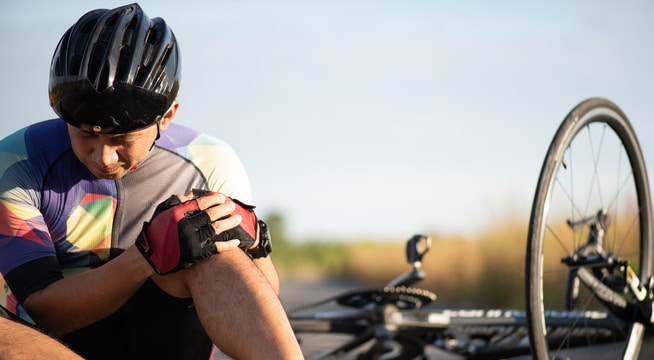Most Common Bicycle Injuries & How to Treat Them
Sports Injuries
•
Apr 2, 2020
Reviewed by:

Bicycles are great devices for exercise, to have fun, and for transportation. Yet, just as with many activities, its use could occasionally result in injuries. If you’ve fallen off a bike — or ran into a pedestrian — you’re well aware of the damage that could result from either of these scenarios. But, what are the most common injuries? How can you treat them? And, is there anything you can do to prevent them?
What are the most common bicycle injuries?
Soft Tissue Injuries
These are superficial injuries to skin that occur from falling off a bike — such as skinning your knees or elbows, cuts and lacerations to the skin, and damage to muscle and tendons from trauma. To treat them, wash your hands to avoid germs from getting into the injury. If the injury is still bleeding, apply gentle pressure with a clean bandage and keep the area elevated until the bleeding stops. Cover with triple-antibiotic cream and a bandage. As days go by, watch for signs of infection — such as redness, swelling, skin that’s warm to the touch, and/or pus. If you notice any of them, seek medical care.
Road Rash
Road rash occurs when you lose skin as you skid along the pavement. While these are also considered soft tissue injuries, road rash tends to be more serious — since it’s susceptible to infections due to grit and dirt that gets embedded in the injured body part. It’s crucial to obtain treatment as soon as possible, as some infections could be life-threatening. Gently scrub the wound with iodine or betadine, apply a layer of triple antibiotic ointment, and cover the wound with a gauze pad. If the injury is large, seek medical care immediately.
Muscle Pain & Soreness
The position required to ride a bicycle can put a lot of strain on your spine if you often ride for long periods of time without taking a break. If you ride for sport, make sure to consult with a coach — or look for YouTube videos — about proper posture while riding your specific type of bike. By the same token, cyclists can also experience pain and tightness of the muscles at the base of the skull and towards the sides of the neck, all the way down to the shoulders. The best ways to prevent this from occurring is to ensure you have a bicycle that’s adequate for your height and using good posture. If you’re already experiencing soreness, use a foam roller to loosen muscle knots. Do static stretching exercises, apply an analgesic ointment, and a heating pad for 20 minutes. If pain persists, see a doctor.
Fractures
Any fall from a high speed — or collision with a car, runner, or another cyclist — could lead to broken bones. Signs include intense pain — especially when applying pressure — a limited range of motion (or an inability to move the injured body part), swelling, and bruising. In more severe cases, the injured body part may look deformed, or you may be able to see the bone protruding from the skin. These types of injuries should always be treated by a doctor. Failing to do so may result in permanent deformity or disability.
Concussions
A concussion is a traumatic brain injury that occurs when the brain is jolted quickly back and forth inside the cranium. The sudden movement can damage blood vessels, brain cells, and/or nerves. These are typically associated with accidents where the cyclist was riding at a high speed or was impacted by a car. The best way to prevent this type of injury is to always wear a helmet — regardless of whether you’re required to do so by law.
Overuse Injuries
This includes discomfort in the perineum (the area between the anus and genitals) and numbness in the genital area, as well as compression neuropathy (squeezed nerves) — which can happen often to cyclists on their ulnar nerve from the pressure of constantly gripping the handlebars. The best way to avoid these types of injuries is to adjust the seat so that it’s higher than the saddle for long-distance riding sessions. Similarly, a downward tilted saddle can reduce stress on the perineum. Installing a wide saddle reduces the likelihood of compressing nerves and blood vessels in the genital area. Finally, make it a point to loosen your grip on the handlebars.
24-Hour Emergency Room Services in Colorado Springs and Texas
If you’ve been injured from a bicycle accident, we can provide you with the care you need. If you have questions or need immediate treatment, your nearest Complete Care location is ready to help, no matter the time of day or night. We offer a variety of services to help you and your family in your time of need. No appointments are necessary.
Find the Complete Care location nearest you.
